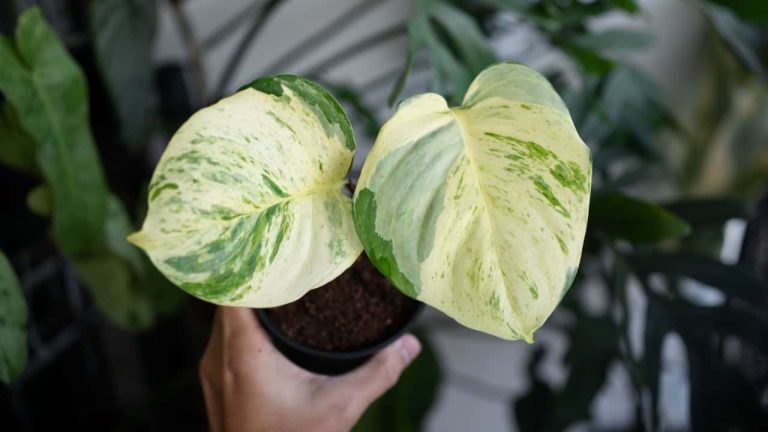Understanding Golden Pothos Brown Spots: Causes and Solutions
Golden pothos (Epipremnum aureum), also known as devil’s ivy, is a popular houseplant cherished for its lush foliage and air-purifying qualities. However, many plant owners encounter a common issue: brown spots on the leaves. These spots can be alarming and may indicate underlying problems that require attention.
In this comprehensive guide, we will explore the causes of brown spots on golden pothos and provide actionable solutions to restore your plant to its vibrant state.
What's On the Page
Common Causes of Brown Spots on Golden Pothos
1. Overwatering
Overwatering is one of the leading causes of brown spots on golden pothos. When the plant’s roots sit in waterlogged soil, it can lead to root rot, which manifests as brown spots on the leaves.
- Symptoms: Yellowing leaves, wilting, and a mushy texture at the base of the stems may accompany the brown spots.
- Solution: Allow the top 1 to 2 inches of soil to dry out before watering again. Ensure the pot has drainage holes to prevent water accumulation. If root rot is suspected, remove the plant from the pot, trim any rotten roots, and repot in fresh, dry soil.
2. Underwatering
On the flip side, underwatering can also cause brown spots. When golden pothos does not receive enough water, the leaves may become dry and develop brown patches.
- Symptoms: Dry, crispy leaf edges and a lack of vibrant green coloration are common.
- Solution: Water your pothos thoroughly until excess water drains out of the pot. Ensure you maintain a consistent watering schedule to prevent the soil from drying out completely.
3. Low Humidity
Golden pothos thrives in higher humidity levels. Low humidity can lead to brown spots and crispy edges on the leaves.

🌿 The Companion Planting & Gardening Book (eBook)
Bigger harvests, fewer pests — natural pairings & simple layouts. $2.40
Get – $2.40
🪴 The Pest-Free Indoor Garden (eBook)
DIY sprays & soil tips for bug-free houseplants. $1.99
Get – $1.99- Symptoms: Leaf edges browning and a general lack of vibrancy.
- Solution: Increase humidity by misting the leaves, placing a humidifier nearby, or using a pebble tray filled with water under the plant pot. Ideally, humidity levels should be between 40% to 60%.
4. Nutrient Deficiencies
A lack of essential nutrients can result in various symptoms, including brown spots. Specifically, deficiencies in nitrogen and potassium may lead to these unsightly spots.
- Symptoms: Leaves may exhibit pale colors along with brown spots, especially on older leaves.
- Solution: Use a balanced, water-soluble fertilizer every 4-6 weeks during the growing season (spring and summer) to ensure your pothos receives adequate nutrients.
5. Pest Infestations
Pests such as spider mites, mealybugs, and aphids can cause damage to golden pothos leaves, resulting in brown spots and other symptoms.
- Symptoms: Visible pests on the leaves, webbing (in the case of spider mites), or sticky residue.
- Solution: Inspect your plant regularly for pests. Use insecticidal soap or neem oil to treat infestations. Make sure to thoroughly spray the undersides of the leaves where pests often hide.
6. Fungal Infections
Fungal infections, particularly leaf spot diseases, can also cause brown spots on golden pothos. These can arise due to excessive moisture on the leaves or poor air circulation.
- Symptoms: Brown spots that may appear wet and may grow in size over time.
- Solution: Improve air circulation around the plant by spacing it adequately and avoiding overhead watering. If you suspect a fungal infection, you may need to remove affected leaves and treat the plant with a fungicide.
7. Sunburn
Excessive exposure to direct sunlight can lead to sunburn, causing brown spots on the leaves.
- Symptoms: Leaves may develop brown, crispy patches that appear bleached.
- Solution: Relocate your golden pothos to a spot with bright, indirect light. If it is currently in direct sunlight, gradually acclimate it to a less intense light environment.
Preventing Brown Spots on Golden Pothos
1. Monitor Watering Habits
Establish a consistent watering routine by checking soil moisture regularly. Use your finger to test the top few inches of soil; if it feels dry, it’s time to water.
2. Maintain Adequate Humidity
To keep humidity levels optimal, consider grouping your plants together or using a humidifier, especially during dry seasons.
3. Fertilize Wisely
Fertilize during the growing season but avoid over-fertilizing, as this can lead to nutrient burn and brown spots.
4. Inspect for Pests Regularly
Check your golden pothos routinely for any signs of pests and take immediate action if you notice any infestations.
5. Provide Proper Light Conditions
Ensure your plant receives the right amount of light. While golden pothos can tolerate low light, it thrives best in bright, indirect sunlight.
Conclusion
Brown spots on your golden pothos can be concerning, but understanding their causes and implementing the right solutions can help restore your plant’s health. By monitoring watering habits, ensuring adequate humidity, and regularly inspecting for pests, you can enjoy a thriving golden pothos that adds beauty and life to your indoor space. With proper care, your golden pothos can continue to grow lush and vibrant for many years to come.
- What Nutrients Do Plants Need – Your Essential Guide To Thriving - December 13, 2025
- Vinegar Mold Spray – Your Natural Garden Guardian Against Unwanted - December 12, 2025
- Organic Insecticidal Soap – Your Ultimate Guide To Eco-Friendly Pest - December 12, 2025

